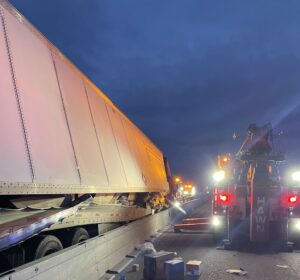New York, N.Y. — A new initiative has been launched to help safety efforts on the highways.
An announcement was made June 6 that Together for Safer Roads (TSR), a leading global NGO focused on building cross-sector partnerships to improve fleet trucking safety, announces the publication of “Seat Belt Safety Standard Operating Procedures: How to create and maintain a culture of safety by promoting seat belt safety procedures.” This new guide marks significant progress in establishing seat belt safety utilization standards as part of TSR’s Fleet Trucking Global Safety Standards Initiative.
The initiative, launched during the 2023 UN Global Road Safety Week, aims to establish operator-focused guidelines and best practices for effective implementation of fundamental safety tools and technologies including: telematics, automatic braking, airbags,, side view mirrors, and seatbelts. The first phase has been dedicated to developing “Gold Star” Standard Operating Procedures (SOPs) aimed at increasing driver seat belt utilization rates for fleets.
According to its press release, extensive research and stakeholder engagement, TSR identified a critical need for detailed SOPs that address both human behavior and specific seat belt hardware and technology. The new handbook, based on insights from fleet managers, drivers, and public and private sector leaders, highlights the importance of consistent seat belt use and offers practical guidance to enhance safety measures.
“Today marks a significant milestone in our mission to improve global fleet trucking safety, said Peter Goldwasser, executive director of Together for Safer Roads. “The SOPs outlined in our guide represent a comprehensive framework for promoting and supporting seat belt usage within organizations.”
Key aspects of the SOPs include:
Training for Seat Belt Compliance: Building a foundation of knowledge and cultivating a culture of safety through comprehensive training initiatives. The SOPs stress the importance of integrating seat belt safety goals into organizational and operational practices. This includes incorporating seat belt usage into driver performance evaluations, and utilizing data analytics to measure and enhance compliance.
Seat Belt Software and Hardware Selection: Adopting the most reliable and effective technological solutions to bolster seat belt compliance and monitoring.
Purchasing and Evaluating Vehicle Seat Belt Safety Systems: Ensuring that the procurement of vehicles and their safety equipment is guided by informed, safety-focused decisions. This involves establishing clear criteria for seat belt safety features and assessing the safety records and seat belt technology of potential vehicle models to maintain compliance with seat belt safety regulations.
Seat Belt Utilization Enforcement: Creating mechanisms for compliance, while ensuring accountability and timely corrective actions.
Communication for Seat Belt Safety Awareness: Establishing clear channels and protocols for disseminating safety information, collecting feedback, and fostering dialogue. To make the necessity of seat belt usage more relatable and impactful, the SOP incorporates interactive training methods and anecdotal storytelling to educate drivers about the importance of seat belt safety.
Documentation of Seat Belt Safety Compliance: Ensuring meticulous record-keeping, accessibility, and regular updates to all seat belt safety-related documents.The SOPs emphasize the importance of measurement and evaluation (M&E) in ensuring the effectiveness, efficiency, and impact of seat belt safety initiatives. They outline the role of M&E in accountability, performance improvement, resource allocation, learning, evidence-based decision-making, impact assessment, transparency, risk management, efficiency, and stakeholder engagement.
Within each section, practices are categorized as currently existing practices, industry best practices, and easy to implement takeaways, providing fleet leaders a range of tools to implement in their own management practices.
The initiative’s development and subsequent testing are being conducted in collaboration with leading fleet partners, including AB InBev, Republic Services, The City of New York Department of Citywide Administrative Services (DCAS), PepsiCo, and Interstate Waste Services. These partners emphasize the collective responsibility of organizations to contribute to long-term improvements in global fleet trucking safety.
“As a major user of roads worldwide, improving the safety of our vehicles and their operation not only benefits us but also enhances road safety for everyone. We’re excited to team up with TSR to set better technical standards on the proper use of seatbelts. This important work demonstrates the positive change industry collaboration can have on our communities,” said Andres Peñate, Global VP for Corporate Affairs of Ab-InBev.
“As the operator of one of the largest independently-owned fleets in the US, and a network of drivers across the globe, maintaining driver safety, health and wellbeing is essential,” said Daniel McGuigan, EHS Director at PepsiCo. “At PepsiCo we’re proud of this important collaboration and look forward to continuing to work to advance seatbelt usage and best practices.”
“Starting with the most fundamental safety instrument of seatbelts is a good choice that shows the thorough nature of this initiative,” said Jim Olson, Vice President, Safety, at Republic Services. “We are committed to supporting these types of efforts to improve fleet safety and ultimately save lives.”
NYC DCAS Deputy Commissioner and Chief Fleet Officer Keith Kerman said, “Wearing your seatbelt is the law. It’s also basic commonsense and the life you save will be your own. As our NYC fleet operators traverse millions of miles of New York City streets, attention to proper seatbelt usage is of utmost importance. We are proud to be part of the effort to call attention to this issue and elevate road safety here in our city and around the world.”
“It is crucial to make sure that every fleet driver buckles up, every time, and these standards will drive that goal,” said Sal Mastriani, Vice President of Risk Management at Interstate Waste Services. “It’s exciting to see this concrete progress being made and to collaborate with TSR on expanding the safety standards.”
The next phase of TSR’s Fleet Trucking Global Safety Standards Initiative will focus on using fleet telematics to drive safety.Increasingly, fleet operators purchase and use telematics systems to improve road safety, monitor their services/products and efficiency, and better support their drivers. Telematics systems gather key data on what is happening on-the-road and in vehicles. To address safety, most fleet operators focus on a few main metrics – speeding, harsh braking, harsh cornering, close following, reversing actions, and seatbelt use – as addressing these behaviors have, to date, shown the best correlation with road safety.
TSR’s report will unpack these key safety telematic metrics and showcase how fleet operators have deployed and refined them in their operations. Focusing on experiences from fleet operators, it provides case studies and other examples that show how organizations are using their telematics data to drive a culture of safety. The target audience for this next report is safety managers who are implementing telematics programs and are looking for support in how to design and implement them. This work will also provide citations and other resource-level information that can be used to support training materials from TSR’s FOCUS program.
Bruce Guthrie is an award-winning journalist who has lived in three states including Arkansas, Missouri and Georgia. During his nearly 20-year career, Bruce has served as managing editor and sports editor for numerous publications. He and his wife, Dana, who is also a journalist, are based in Carrollton, Georgia.














